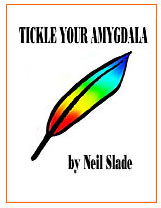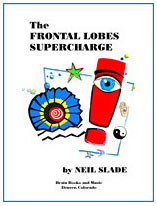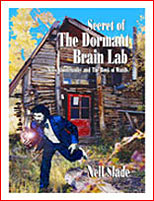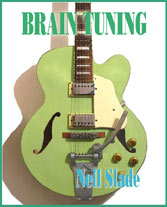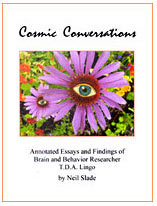
|
PRINTED AND
NEW BRAIN BOOK! TICKLE YOUR AMYGDALA
The Whole Universe Brain DVD Special 40 Hours! JUST $49
5 Books 20 Audio Albums + BONUSES Read About It Here ANYWHERE IN THE WORLD
ALL INSTANT
Much more at The Amazing Brain Book and Music Store
|
The AMYGDALA is a key brain master switch in helping us learn what to fear- as
well as what NOT to fear.
C.I.C.I.L. Creativity-Imagination-Cooperation-Intuition-Logic
i.e., FRONTAL LOBES
processes.
This brain self-control, via frontal lobes intelligence
control of reactive aspects of the amygdala, is something we've been teaching since
1957, starting at our Colorado Dormant Brain Research facility, located 40 miles
west of Denver, high in the Colorado Rockies. (And you can get "high"
too with a little brain self-control....)
The pre-frontal cortex teaches the amygdala how NOT to
panic and experience freezing negative emotions.
SCIENTISTS have found the seat of fear in the brain, proving that one of the most potent human emotions has a chemical basis and raising the prospect of a new generation of drugs that could make man fearless. In a ground-breaking study, researchers have shown how the electrical circuitry of the brain is altered by an individual's exposure to frightening experiences. The study will increase our understanding of how fear can overwhelm the normal functioning of the brain and open the way to the development of effective treatments to combat panic attacks, anxiety and phobias. Scientists found that the emotion of fear is bio-chemically manufactured in tiny pathways between nerve cells in a small, almond-shaped structure within the brain called the , which is thought to be central to the processing of other primal emotions. A key finding is that certain connections between the nerve cells within the amygdala become strengthened when someone learns to fear something. This raises the rate at which nervous signals can flow through the brain's fear center, and so increases the intensity of the emotion. In this way the scientists have shown that, emotionally, the brain can learn from experience. Patricia Shinnick-Gallagher, professor of pharmacology and toxicology at the University of Texas, who led one of the two research teams, says it is the first time anybody has shown that the experience of fear has a physical impact on the wiring of the brain. "I guess you could say we have described the seat of fear in the brain." "We can now determine the actual mechanisms underlying fear and can specifically design drugs to treat patients who cannot exert control over their fears," she said. The latest findings on how the amygdala handles fear stem from the work of Professor Joseph LeDoux, a leading authority on the emotional nature of the brain at the Center for Neural Science at New York University. He discovered that rats conditioned to a frightening or painful situation developed more intense neural communication in the amygdala than those who were not. The rats were given a small electric shock following the sound of a buzzer. They learnt to be fearful of the sound of the buzzer. "We are born with the ability to be afraid but we learn about most things that make us afraid," said LeDoux. Professor Barrie Gunter, a psychologist at the University Of Sheffield, said that fear was one of the most basic emotions and evolved as a vital survival reflex. It provoked a range of physical responses - including increased adrenaline production and raised heart rate - which improved an animal's ability to defend itself or to escape from danger. "It's a way of learning to cope with our environment and we still have this vestigial need to face up to challenging situations," Gunter said. Excessive fear can, however, be crippling. In wartime, exposure to repeated terror has caused total psychiatric collapse among soldiers. In the second world war, more than half a million American soldiers were treated for mental illness provoked by uncontrollable fear. In civilian life, psychological disorders such as anxiety and phobias are often untreatable. Valium, the most popular anti-anxiety drug, carries a risk of serious side-effects, from loss of balance to hallucinations. The discovery of the amygdala's fear circuitry now offers scientists a specific target to design drugs that affect only the fear centre of the brain, leaving other functions unimpaired. The amygdala, long considered one of its most ancient structures, which first evolved many millions of years ago, long before the evolution of the "higher" centres of the brain in the cortex responsible for thinking and consciousness. "We have shown that the (posterior) amygdala is like the hub in the center of a wheel of fear. If we understand the pathways of fear, it will ultimately lead to better control," said LeDoux. [SLADE] Simple solution- Learn how to click forward!!
Back to
The Library From Another Dimension
|
